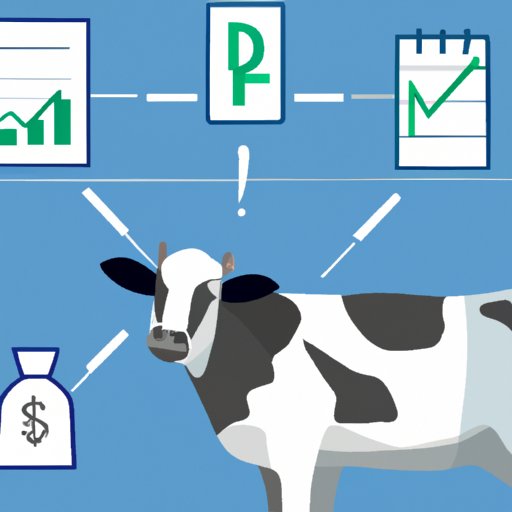
Overview of Dairy Cow Prices Based on Type and Age
When considering how much a dairy cow costs, there are several factors to take into account. The type of cow, its age, as well as regional variations can all affect the price. Below, we’ll look at different types of dairy cows and the average prices based on age.
Different Types of Dairy Cows
Dairy cows come in a variety of breeds, each with its own unique traits. The most popular breeds for commercial milk production are Holstein, Jersey, Brown Swiss, and Ayrshire.
Holstein cows produce the most milk, with some cows producing up to 30,000 pounds of milk per year. They are also the most common breed of dairy cow. Jerseys are smaller than Holsteins and produce less milk overall, but the milk they do produce is higher in fat and protein content. Brown Swiss cows have great longevity and produce a high volume of milk. Ayrshires are known for their hardiness and adaptability, making them well suited to a wide range of climates.
Average Prices Based on Age
When it comes to pricing, dairy cows are generally divided into two categories: calves and adult cows. Calves usually range from $500-$1,500, while adult cows can cost anywhere from $800 up to $5,000 or more. The price will depend on the cow’s breed, genetics, and health.

A Comprehensive Guide to Buying a Dairy Cow
If you’re thinking about investing in a dairy cow, there are a few steps you should take to ensure you get the best deal.
Researching the Right Cow
Before you commit to buying a cow, make sure you know what you’re looking for. Research different breeds to determine which one is best suited to your needs. Consider factors such as the amount of milk each cow produces, the size of the cow, and the cow’s adaptability to different climates.
Finding Reliable Sellers
Once you’ve done your research, it’s time to start shopping around for a reliable seller. Look for reviews and ratings online, and ask other farmers in the area if they have any recommendations. It’s also a good idea to visit potential sellers in person to get a better sense of the cows they offer.
Budgeting for Associated Costs
In addition to the cost of the cow itself, there are a number of additional expenses to consider. These include transportation costs, veterinary bills, feed, and other maintenance expenses. Make sure you factor these costs into your budget before making a purchase.
Factors That Affect Dairy Cow Cost
When it comes to the cost of a dairy cow, there are a few key factors to consider.
Genetics
One of the main factors that affects the cost of a dairy cow is its genetics. Cows with superior genetics tend to produce more milk and be healthier overall, so they tend to cost more.
Feed Costs
Another factor to consider is the cost of feed. Feed accounts for a large portion of the total cost of owning a dairy cow, so it’s important to factor this in when budgeting.
Maintenance Expenses
Finally, there are a number of additional costs associated with owning a dairy cow. These include things like veterinary bills, vaccinations, deworming, hoof trimming, and other maintenance expenses.
An In-depth Look at the Cost of Purchasing a Dairy Cow
When it comes to the initial purchase price of a dairy cow, there are a few things to keep in mind.
Initial Purchase Price
As mentioned above, the cost of a dairy cow will vary depending on its breed, age, and genetics. Generally speaking, calves tend to cost less than adult cows.
Transportation Costs
If you’re purchasing a cow from a breeder, you’ll likely need to arrange for transportation. This can add significantly to the overall cost, so make sure you factor this in when budgeting.
Veterinary Expenses
Finally, you’ll need to factor in the cost of veterinary care. This includes things like vaccinations, deworming, hoof trimming, and other medical treatments.
Average Costs of Dairy Cows by Region
The cost of a dairy cow can vary significantly from region to region. Factors such as demand, availability, and local regulations can all affect the price.
Regional Variations in Cost
In general, dairy cows tend to cost more in urban areas due to higher demand and limited availability. Similarly, cows in rural areas tend to cost less due to lower demand and greater availability. Additionally, the cost of feed and other supplies can vary significantly from region to region, so make sure you factor this in when budgeting.

The Pros and Cons of Investing in Dairy Cows
Finally, it’s important to consider the pros and cons of investing in dairy cows.
Benefits of Owning a Dairy Cow
The main benefit of owning a dairy cow is the potential for income. Dairy cows can produce a steady stream of milk, which can be sold for a profit. Additionally, dairy cows are relatively low maintenance and can provide companionship for their owners.
Potential Drawbacks of Investing in Dairy Cows
On the other hand, there are a few potential drawbacks to owning a dairy cow. For starters, they require significant investments of both time and money. Additionally, dairy cows can be prone to disease and require regular veterinary care. Finally, dairy cows can be difficult to transport, so if you plan to move your cow you may incur significant costs.
(Note: Is this article not meeting your expectations? Do you have knowledge or insights to share? Unlock new opportunities and expand your reach by joining our authors team. Click Registration to join us and share your expertise with our readers.)
